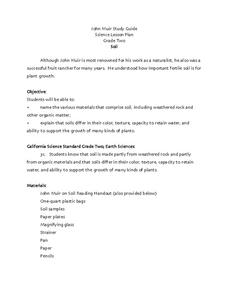Curated OER
Tracing and Counting
For this counting worksheet, students trace the numbers from 1 to 10. Students count and color the animals and tell how many are animals that live in the water.
Curated OER
science: Light Up the Ocean
students investigate light levels under the ocean by conducting several simulations. After creating solutions representing seawater, they shine a light sensor on it to discover how light diffuses and is absorbed by the impurities in the...
Curated OER
Symbols of America
Learners learn about and discuss the important symbols that represent America. In this symbols lesson plan, students cut out pictures of the bald eagle, American flag, Liberty Bell, and more. They color them when they have them cut out.
Curated OER
Serial Dilution of CuSO4 and Changing the Value of Paint
Students relate solution concentration and saturation to color and compare methods of changing value and color intensity with paint solutions.
American Chemical Society
Powder Particulars
By both demonstration and hands-on investigation, physical science fanatics come to know that some materials react when they come together. Adding vinegar to both baking soda and to baking powder, the difference between the two is clear....
Curated OER
I See a Rainbow
Students identify the different colors in a rainbow. They experiment with dropping food coloring into a water and then making ice cubes. They discuss what happens to the water in the freezer
Curated OER
Chromatography Lab
Students discover the components of primary and secondary colors. In this physical science lesson, students create a set up in which water will separate a color into the component colors along a piece of filter paper. Students will then...
Curated OER
Mixing Primary Colors
Students demonstrate ways to mix primary colors. In this visual arts instructional activity, students use gelatin and food coloring to create various color mixtures. Students also use tempra paint to mix colors together.
Curated OER
Indicators For Acids and Bases
Fourth graders compare the color of cabbage water when acids and bases are mixed in. In this acids and bases lesson plan, 4th graders use cabbage water and mix in acids and bases that the teacher prepares before hand. They observe the...
Curated OER
Acid/Base Indicators
Students use plant materials as indicators of acids and bases. In this acid/base indicators lesson plan, students use boiled beets, cabbage, flowers, teas or berries that have been boiled with alcohol to test various acids and bases....
Curated OER
Colors
Students learn about the Impressionist painters' use of color and how it connected to early nineteenth century scientific theories about color. In this colors lesson plan, students explore combinations of primary and secondary colors,...
Curated OER
North American Biomes
In this Science worksheet, learners color a biome map of North America. Students color the map by solving the clues listed on a separate sheet of paper.
Curated OER
The Effects of the Calcium Ion on Cooked Dry Beans
Students investigate the effects of calcium ions on the quality characteristics of cooked dry beans. In this calcium ion and dry bean investigation lesson plan, students soak dry beans using 2 different soaking techniques and 2 different...
Curated OER
Underwater Hide and Seek
Students explain why color patterns that are easy to see above water may be difficult to detect under water and experience the problems predators face when searching for camouflaged prey.
Curated OER
United States: Physical Features Fun
In this map worksheet, young scholars color and trace eleven listed features on a map of the United States. Students answer six additional questions about the map. A United States map is not provided. However, websites are provided to...
Curated OER
Flower Structure and Reproduction
In this plant science worksheet, learners color and label the different parts of the flower. They write short answers to 14 questions about flowers.
Curated OER
Monochromatic Painting
Learners create a piece of monochromatic art. In this monochromatic art lesson, students design a piece of art and analyze their painting objectively. Learners connect color and emotions.
Curated OER
Structure of the Nephron
In this nephron worksheet, students color the parts of the nephron and answer five questions about the structures and functions of the parts of the nephron.
Curated OER
Household Mysterious Chemicals
In this household chemicals instructional activity, students fill in 10 blanks with answers about testing household materials. Students must also fill out a data table about what color each material turns when placed in cabbage juice.
Curated OER
SOIL
Second graders name the various materials that comprise soil, including weathered rock and other organic matter; and explain that soils differ in their color, texture, capacity to retain water, and ability to support the growth of many...
Curated OER
Soil
Second graders name the various materials that comprise soil, including weathered rock and other organic matter. They explain that soils differ in their color, texture, capacity to retain water, and ability to support the growth of many...
Curated OER
The Country of Venezuela
In this map skills of Venezuela worksheet, students use an outline map to find an label important cities landforms, and bodies of water. Students label and color code 10 answers.
Curated OER
Activity Plan 3-4: Freezing Paper
Students discover how paper reacts to temperature changes in order to cultivate their science prediction skills. In this frozen paper investigation, students paint pieces of newsprint with water and then freeze them overnight,...
Curated OER
The Euglena and Spirogyra
For this Euglena and Spirogyra worksheet, students read about these two Protozoans and they answer fourteen questions about their specified structures and functions. They color a diagram of Euglena and Spirogyra and label their parts.
Other popular searches
- The Color of Water
- Color Schemes in Watercolor
- Temperature Water Food Color
- Heat Water Food Color
- 'The Color of Water
- Food Color and Water Mixed

























